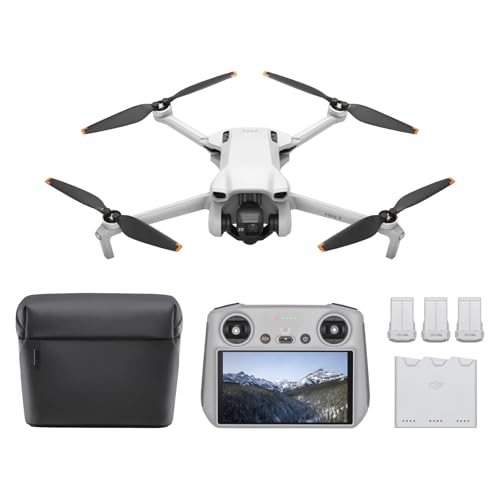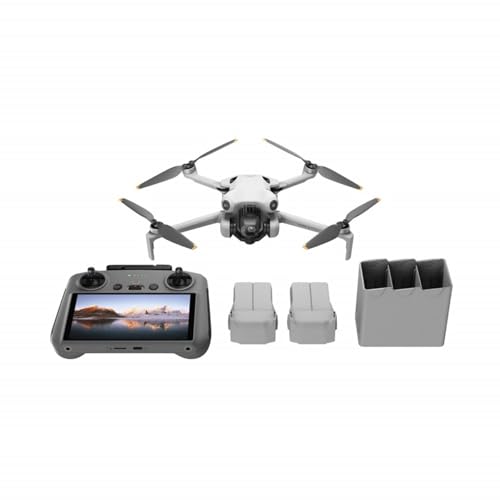So, you’re looking to push the boundaries, explore distant horizons, and experience the thrill of true long-range FPV drone flying? Awesome! But to do that effectively and safely, you need more than just a great drone; you need the best controller for long range FPV drone adventures. The right remote control system is your lifeline to your drone, providing the precision, reliability, and signal stability crucial for those epic flights far from home.
When we talk about long-range FPV, we’re not just talking about flying a few hundred feet. We’re thinking miles, often out of visual line of sight (where regulations permit and with spotters). This demands a controller that boasts robust transmission protocols, excellent anti-interference capabilities, and often, telemetry feedback to keep you in the know.
We’ve scoured the market to bring you a selection of top contenders, covering various needs and setups – from dedicated FPV remotes to comprehensive drone packages. Let’s dive in and find the perfect match for your aerial explorations!
DJI FPV Remote Controller 3

If you’re already flying or planning to fly with DJI’s cutting-edge FPV systems, the DJI FPV Remote Controller 3 is an obvious and excellent choice. This controller is engineered to seamlessly integrate with DJI’s O4 video transmission technology, ensuring a stable and clear video feed even when your drone is miles away. It’s lighter and offers an extended operating time compared to its predecessors, letting you stay in the air longer without worrying about your controller’s battery. The refined ergonomics, including extended control sticks, cater to both single and dual-fingered pilots, making it a joy to hold for those marathon long-range sessions.
Key Features:
* Engineered for DJI O4 video transmission with integrated antenna design.
* Lighter than previous models with longer operating time.
* Extended control sticks (2mm) for precise single and dual-fingered control.
* Includes Normal, Sport, and Manual modes for varied skill levels.
* Adjustable control stick feel with included screwdriver.
* Compatible with popular simulators like Liftoff, Uncrashed, DCL, and The Drone Racing League.
* Broad compatibility with DJI Neo, DJI Avata 2, DJI O3 Air Unit, DJI O4 Air Unit Pro, DJI O4 Air Unit.
Pros:
* Exceptional signal stability and range with DJI O4.
* Lightweight design enhances comfort during long flights.
* Versatile flight modes for beginners to advanced pilots.
* Excellent build quality and tactile feel.
* Wide compatibility within the DJI ecosystem.
Cons:
* Primarily designed for DJI FPV drones, limiting use with other brands.
* Higher price point compared to some generic controllers.
User Impressions:
Pilots consistently praise the DJI FPV Remote Controller 3 for its buttery-smooth controls and rock-solid connection. Many highlight the peace of mind offered by the O4 transmission for distant flights, making it a favorite among those who value reliability and a premium flight experience within the DJI ecosystem. The improved battery life is a definite bonus for extended adventures.
GPS Drone with Camera 4.5″ LCD Screen Remote Control, FPV…

While this product is a complete drone package, its included remote control brings some noteworthy features that enhance the flying experience for hobbyists looking for extended range within its class. The standout here is the integrated 4.5-inch HD display directly on the remote, providing real-time FPV transmission without needing a separate phone or goggles. This immediate visual feedback, combined with precision GPS navigation on the drone itself, offers a more controlled and reassuring flight experience. With an advertised 400m control distance, it significantly expands exploration possibilities compared to many entry-level drones, making it a decent contender for pilots seeking a step up in remote control systems for more expansive aerial photography.
Key Features:
* Remote Control with integrated 4.5-inch HD display for real-time FPV transmission.
* GPS drone with HD camera for crystal-clear aerial footage.
* SD Card Storage: Saves photos/videos directly to the SD card with one-touch operation.
* Precision GPS Navigation for rock-solid positioning and automatic return.
* Extended Operation Range: 250m mapping capability and 400m control distance.
* Wind-resistant design for stable flight outdoors.
Pros:
* Integrated FPV screen simplifies setup and reduces clutter.
* GPS functionality enhances stability and safety with auto-return.
* HD camera captures impressive visuals for its price point.
* Easy SD card storage for footage.
* Good range for recreational pilots looking beyond basic drones.
Cons:
* 400m range might not be considered “true long-range” by experienced FPV pilots.
* Remote is specific to this drone package.
* Less customization options compared to dedicated FPV transmitters.
User Impressions:
Users appreciate the convenience of the built-in screen and the drone’s stable flight characteristics thanks to GPS. Many find the image quality impressive for a drone in this category. While professional long-range FPV pilots might seek greater distances, casual fliers and those new to the hobby find the extended control distance liberating and enjoyable for exploring larger areas.
AKK A1918 5.8G Long Range VTX FPV Transmitter…

Alright, let’s be clear: the AKK A1918 isn’t a controller in the traditional sense, but it is an absolutely vital component for achieving long-range FPV. Think of it as the drone’s voice, transmitting the video feed back to your receiver. For any best controller for long range FPV drone setup to work, you need a powerful and reliable video transmitter (VTX) like this one on your drone. Its ability to switch between 200mW, 400mW, 800mW, and even 1000mW output power means you can significantly boost your video signal strength, pushing your FPV range much further. The SmartAudio support is a huge convenience, allowing you to change VTX settings right from your Betaflight OSD, which is essential when you’re out in the field.
Key Features:
* SmartAudio support for changing VTX settings via Betaflight OSD.
* One-button frequency and power setup for manual adjustments.
* Built-in Microphone allows you to hear your quad’s motors and surroundings.
* Wide voltage input (7-28V, 2-6s battery compatible) with 5V output for FPV camera.
* Power switchable: 200mW/400mW/800mW/1000mW for varied range requirements.
Pros:
* High power output (up to 1000mW) dramatically extends FPV video range.
* SmartAudio integration simplifies configuration.
* Built-in mic adds an immersive audio element to FPV.
* Flexible voltage input accommodates various drone builds.
* Durable design suitable for FPV drone use.
Cons:
* Requires a separate FPV receiver and controller.
* High power settings can generate heat, requiring good airflow.
* Installation requires some DIY drone building knowledge.
User Impressions:
FPV enthusiasts often highlight the AKK A1918’s impressive power and clean signal. Many user reviews praise the reliability of the video link over long distances, stating it greatly contributes to their confidence during extended flights. The convenience of SmartAudio is frequently mentioned as a time-saver, and the built-in microphone is a popular bonus for a more engaging flight experience.
Radiolink AT9S Pro 10/12 Channels Radio Transmitter and…

Now we’re talking about a true powerhouse for the serious FPV pilot seeking the best controller for long range FPV drone flight. The Radiolink AT9S Pro is a feature-rich radio transmitter renowned for its exceptional anti-interference capabilities, thanks to its DSSS&FHSS communication technology. This ensures incredibly stable signal transmission, capable of controlling your drone up to an astonishing 2.1 miles (3.4 km) in the air. Beyond just range, it offers comprehensive telemetry data – from battery voltage and speed to altitude and RSSI (signal strength) – all displayed real-time on its 2.8-inch LCD screen. Plus, its multi-function port means it’s ready for advanced long-range modules like TBS Crossfire and ELRS, making it incredibly versatile for pushing those range limits even further.
Key Features:
* DSSS&FHSS communication technology for excellent anti-interference and stable signal.
* Long-range control up to 2.1 miles (3.4 km) in the air.
* 10/12 Channels with extensive programmable mixes and switch assignments.
* Real-time information telemetry (with PRM-01/PRM-03 modules) including RSSI, voltage, speed, altitude, distance.
* 3-in-1 multi-function port supports simulators, TBS Crossfire Protocol (915 Module), and ELRS long-range control modules.
* Safety Reminders: RSSI alerts, low voltage alarm, failsafe protection with audible, vibratory, and visual warnings.
* 2.8-inch LCD screen for clear information display.
Pros:
* Outstanding control range and signal stability.
* Extremely versatile with support for advanced long-range modules (Crossfire, ELRS).
* Comprehensive real-time telemetry is a huge safety and performance advantage.
* Robust anti-interference technology ensures reliable communication.
* Ergonomic design with tactile controls and clear display.
Cons:
* Telemetry modules (PRM-01/PRM-03) are often sold separately.
* Requires a learning curve due to its extensive features and customization options.
* Not as plug-and-play as some dedicated drone remotes.
User Impressions:
Pilots consistently rave about the AT9S Pro’s reliability and impressive transmission range. Many highlight its compatibility with advanced long-range modules as a game-changer, allowing them to truly customize their long-range setups. The clear telemetry data and safety alarms are frequently cited as confidence-boosters for pushing farther out. It’s a favorite among experienced FPV drone pilots who demand performance and flexibility.
LANSAND Brushless Motor Drone with Camera for Adults 4K…

Here’s another full drone package where the remote control contributes to an enhanced flying experience, especially for beginners moving beyond basic toy drones. The LANSAND drone and its accompanying 2.4GHz remote offer a respectable control range of up to 490-720 feet, paired with a 5GHz FPV transmission for a clear, fluent real-time image directly to your phone app. While not “miles-long” FPV, this range is excellent for recreational pilots wanting to explore a larger area or practice their FPV skills with a more capable drone. The inclusion of brushless motors provides superior wind resistance and durability, contributing to a more stable flight platform, which in turn makes the remote control feel more responsive and effective. Plus, its sub-249g weight means no FAA registration is required, making it an accessible entry point to more capable drones.
Key Features:
* Under 249g weight, no FAA registration required.
* 4K UHD Camera with 120° FOV and 90° adjustable lens (38402160 stills, 20481152 video).
* 2.4GHz Remote and 5GHz FPV Transmission for 490-720 ft range.
* Stable Flight with powerful brushless motors for wind resistance and longevity.
* Easy for Beginners: Optical Positioning, Headless Mode, 3 Speed Modes.
* Emergency alerts for out-of-control range/power or signal interruption.
* Fun tricks (3D flips, auto rotation) and app control features.
* Long-lasting rechargeable battery (up to 40 minutes with two batteries).
Pros:
* Excellent range for a beginner-friendly 4K drone.
* Brushless motors provide superior stability and durability.
* No FAA registration required due to low weight.
* Intuitive controls and beginner-friendly features.
* Good battery life for extended flight sessions.
Cons:
* The 490-720 ft range isn’t considered “long-range” for advanced FPV pilots.
* Remote is specific to this drone.
* FPV transmission relies on a smartphone, which can introduce latency.
User Impressions:
Many users commend the LANSAND drone for its ease of use and the impressive quality of its 4K camera. The stable flight, even in light wind, is frequently highlighted, making the control experience very enjoyable. Beginners especially appreciate the extended range over cheaper toy drones and the clear FPV feed, seeing it as a great stepping stone into more serious drone photography and FPV flying.
Frequently Asked Questions (FAQ) about Long-Range FPV Drone Controllers
Q1: What exactly defines “long range” for FPV drones?
A1: The definition of “long range” can vary. For casual pilots, it might mean hundreds of meters (e.g., 400-700 ft). However, for dedicated FPV pilots, “long range” typically refers to flights extending several kilometers (miles) from the pilot, often requiring specialized remote control systems and video transmission gear.
Q2: Why is a good controller so important for long-range FPV?
A2: A good controller is your most critical link to the drone. For long-range FPV, it ensures stable and reliable signal transmission over vast distances, minimizes control latency for precise maneuvers, and often provides crucial telemetry data (like battery voltage, RSSI) to keep you informed of your drone’s status far away. Without a reliable controller, long-range flights are risky and unsafe.
Q3: What features should I look for in a best controller for long range FPV drone?
A3: Look for strong transmission range (often measured in kilometers/miles), advanced communication protocols (like DSSS, FHSS, or support for modules like ELRS/Crossfire), low latency, excellent anti-interference capabilities, good battery life, ergonomic design for comfort, and potentially telemetry feedback. Programmability and compatibility with simulators are also great bonuses.
Q4: Do I need a separate video transmitter (VTX) for long range FPV?
A4: Yes, absolutely! While your controller sends commands to the drone, a separate VTX (Video Transmitter) on the drone is responsible for sending the live video feed back to your FPV goggles or screen. For long-range FPV, a powerful and reliable VTX with high output wattage (like the AKK A1918 reviewed above) is just as crucial as a capable remote controller to maintain a clear video feed.
Q5: Can I use a beginner drone’s remote for true long-range FPV?
A5: Generally, no. Beginner drone remotes, while suitable for their bundled drones’ capabilities, typically have limited range (often only a few hundred feet) and use simpler, less robust remote control systems. True long-range FPV requires dedicated controllers and drones with advanced communication hardware designed for greater distances and signal integrity.
Q6: What’s the difference between 2.4GHz, 5.8GHz, and systems like ELRS/Crossfire for range?
A6:
* 2.4GHz: Commonly used for control signals due to its good penetration and range. Many standard drone remotes operate on this frequency.
* 5.8GHz: Primarily used for FPV video transmission due to its higher bandwidth for clearer video, but it has shorter range and poorer penetration than 2.4GHz.
* ELRS (ExpressLRS) & Crossfire (TBS Crossfire): These are advanced long-range radio systems that typically operate on lower frequencies (like 900MHz or sometimes 2.4GHz with optimized protocols). They offer significantly better range, penetration, and link robustness than standard 2.4GHz systems, making them ideal for dedicated long-range FPV drone pilots.
Q7: How does controller ergonomics affect long-range flying?
A7: When you’re flying for extended periods, comfort is key. A controller with good ergonomics – proper weight distribution, comfortable grip, well-placed gimbals and switches – reduces fatigue in your hands and wrists. This allows you to maintain precise control and focus on your flight, which is crucial for safety and enjoyment during those epic long-range FPV adventures.



